Financial Performance Management Report: ABF, Sainsbury's and IR
VerifiedAdded on 2022/11/25
|16
|4533
|271
Report
AI Summary
This report provides a comprehensive financial performance analysis of Associated British Foods (ABF) and its competitor, Sainsbury's. The analysis includes a detailed ratio analysis comparing liquidity, solvency, profitability, efficiency, and market prospect ratios for both companies over two years. The report then critically evaluates the Balanced Scorecard (BSC) as a strategic management system, highlighting its benefits in measuring performance across various perspectives and connecting long-term strategy with short-term actions. Finally, the report critically analyses the benefits and challenges of adopting Integrated Reporting (IR) for ABF, discussing its advantages and disadvantages. The report concludes with a summary of the findings and insights into the financial performance and strategic management of the companies.
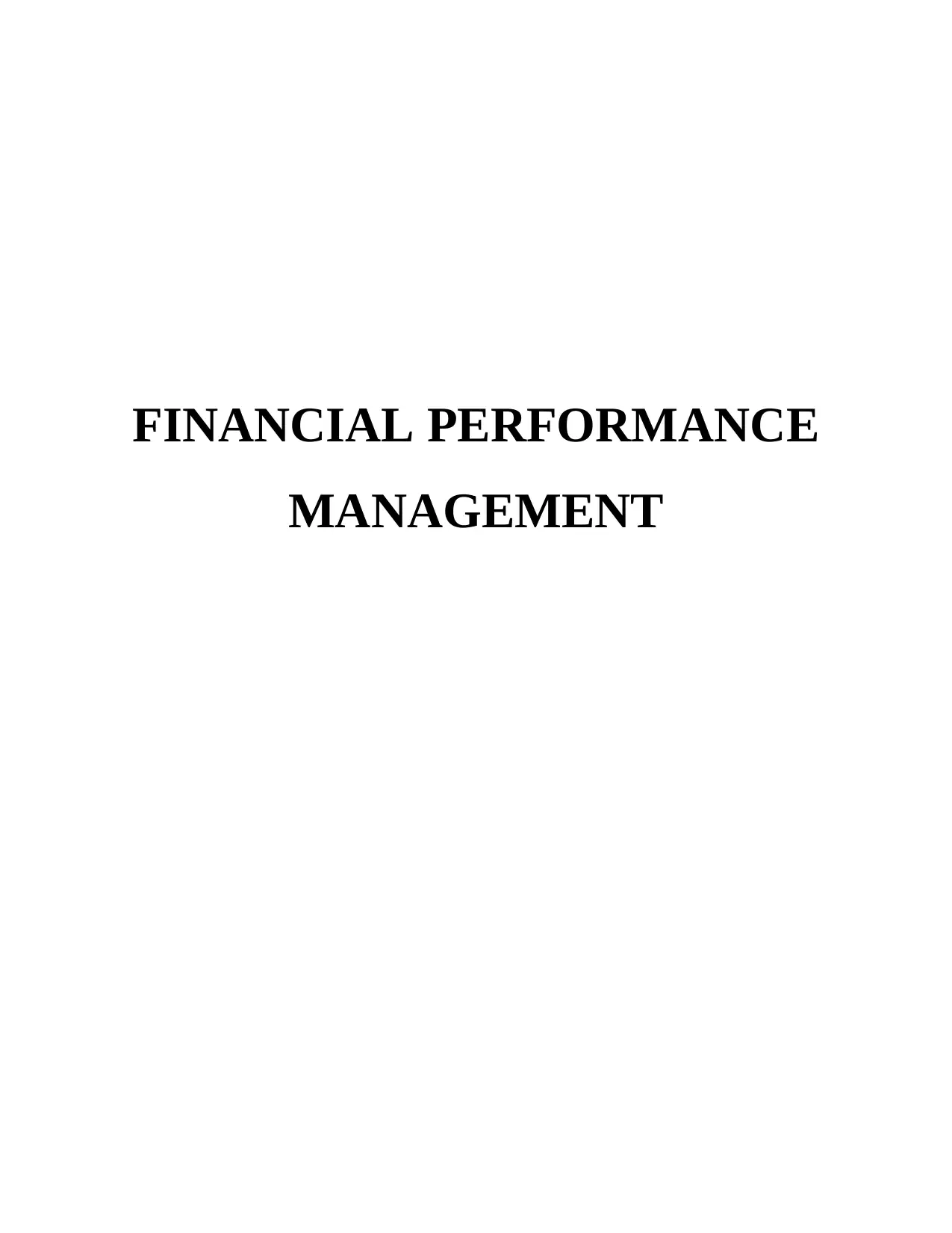
FINANCIAL PERFORMANCE
MANAGEMENT
MANAGEMENT
Paraphrase This Document
Need a fresh take? Get an instant paraphrase of this document with our AI Paraphraser
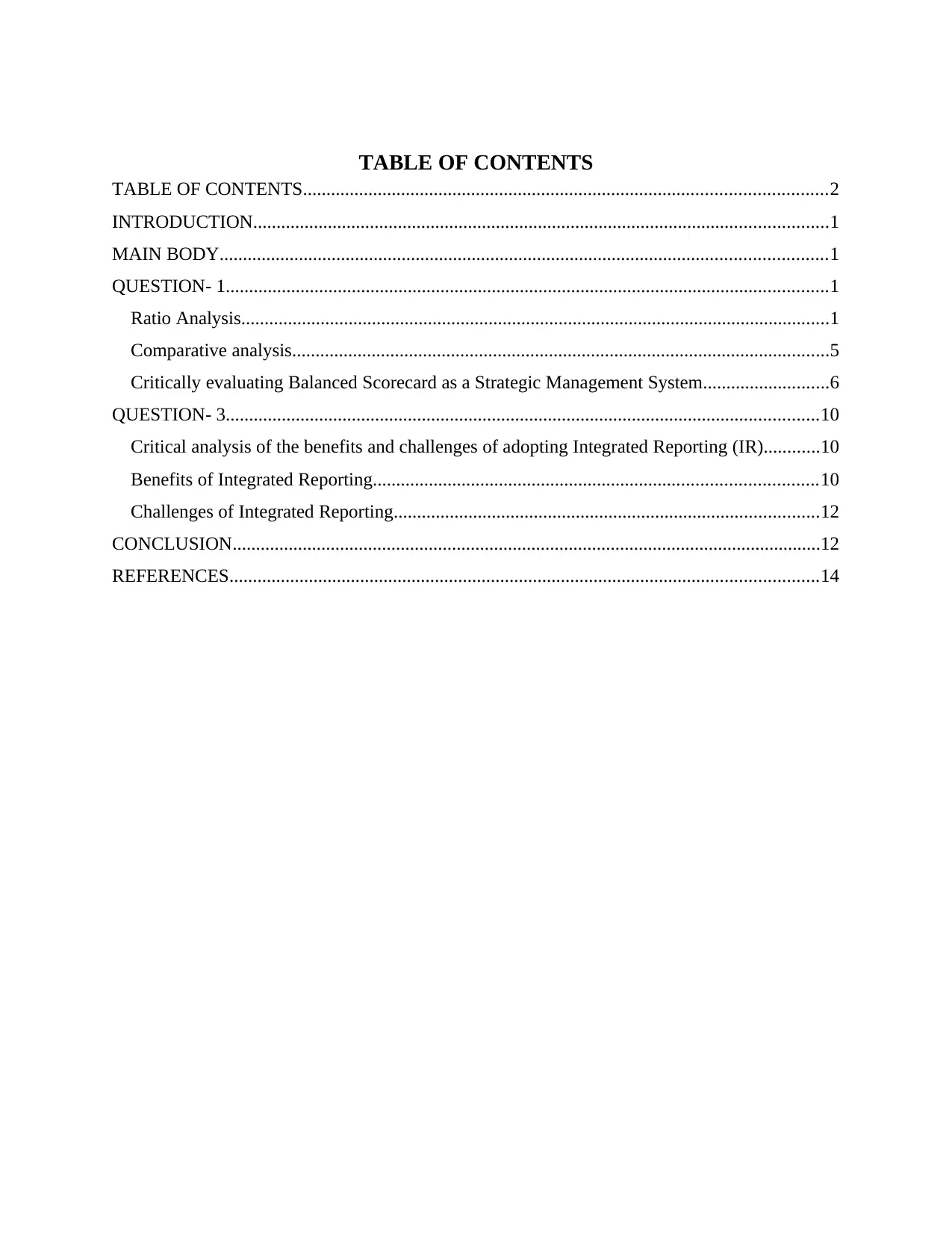
TABLE OF CONTENTS
TABLE OF CONTENTS................................................................................................................2
INTRODUCTION...........................................................................................................................1
MAIN BODY..................................................................................................................................1
QUESTION- 1.................................................................................................................................1
Ratio Analysis..............................................................................................................................1
Comparative analysis...................................................................................................................5
Critically evaluating Balanced Scorecard as a Strategic Management System...........................6
QUESTION- 3...............................................................................................................................10
Critical analysis of the benefits and challenges of adopting Integrated Reporting (IR)............10
Benefits of Integrated Reporting...............................................................................................10
Challenges of Integrated Reporting...........................................................................................12
CONCLUSION..............................................................................................................................12
REFERENCES..............................................................................................................................14
TABLE OF CONTENTS................................................................................................................2
INTRODUCTION...........................................................................................................................1
MAIN BODY..................................................................................................................................1
QUESTION- 1.................................................................................................................................1
Ratio Analysis..............................................................................................................................1
Comparative analysis...................................................................................................................5
Critically evaluating Balanced Scorecard as a Strategic Management System...........................6
QUESTION- 3...............................................................................................................................10
Critical analysis of the benefits and challenges of adopting Integrated Reporting (IR)............10
Benefits of Integrated Reporting...............................................................................................10
Challenges of Integrated Reporting...........................................................................................12
CONCLUSION..............................................................................................................................12
REFERENCES..............................................................................................................................14
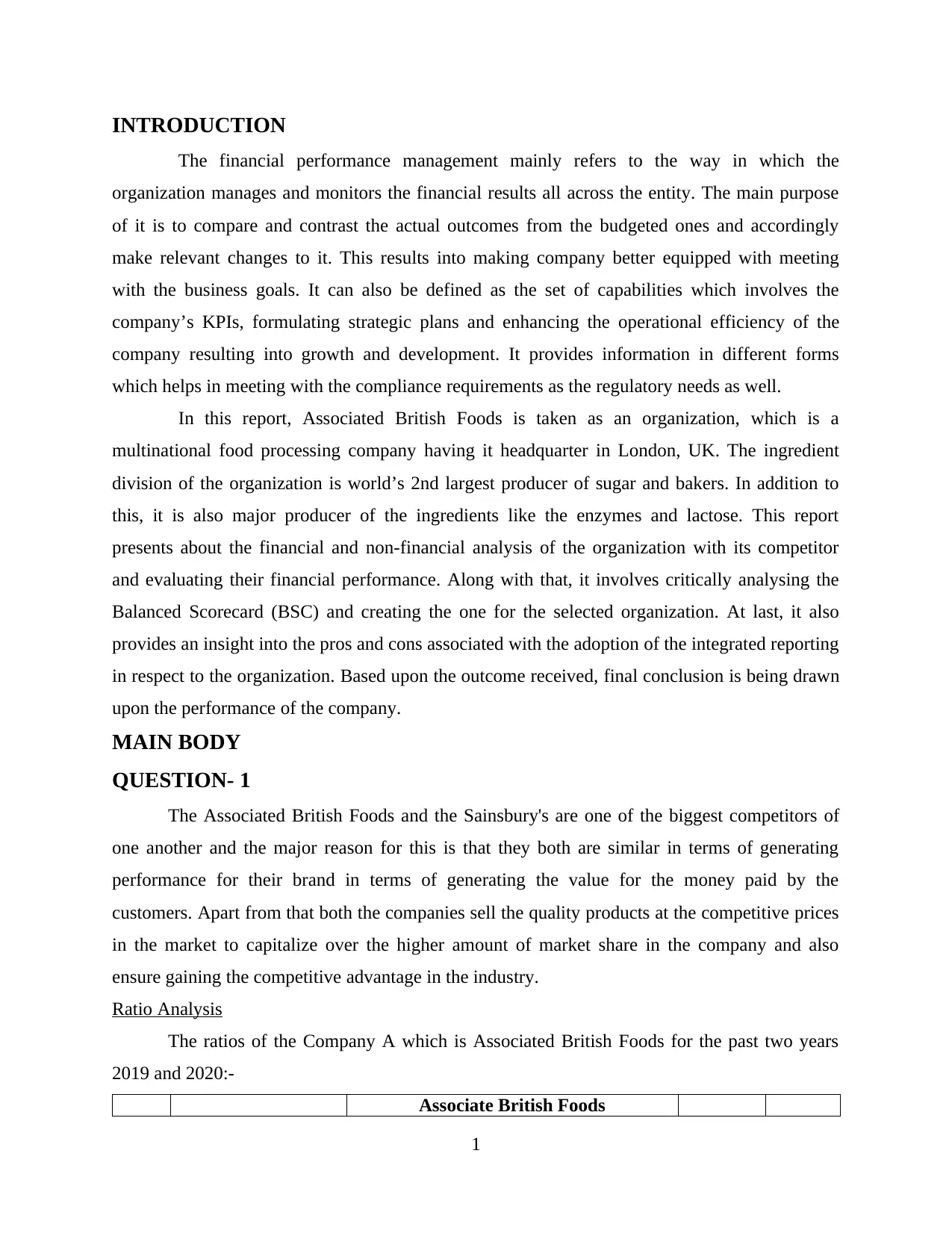
INTRODUCTION
The financial performance management mainly refers to the way in which the
organization manages and monitors the financial results all across the entity. The main purpose
of it is to compare and contrast the actual outcomes from the budgeted ones and accordingly
make relevant changes to it. This results into making company better equipped with meeting
with the business goals. It can also be defined as the set of capabilities which involves the
company’s KPIs, formulating strategic plans and enhancing the operational efficiency of the
company resulting into growth and development. It provides information in different forms
which helps in meeting with the compliance requirements as the regulatory needs as well.
In this report, Associated British Foods is taken as an organization, which is a
multinational food processing company having it headquarter in London, UK. The ingredient
division of the organization is world’s 2nd largest producer of sugar and bakers. In addition to
this, it is also major producer of the ingredients like the enzymes and lactose. This report
presents about the financial and non-financial analysis of the organization with its competitor
and evaluating their financial performance. Along with that, it involves critically analysing the
Balanced Scorecard (BSC) and creating the one for the selected organization. At last, it also
provides an insight into the pros and cons associated with the adoption of the integrated reporting
in respect to the organization. Based upon the outcome received, final conclusion is being drawn
upon the performance of the company.
MAIN BODY
QUESTION- 1
The Associated British Foods and the Sainsbury's are one of the biggest competitors of
one another and the major reason for this is that they both are similar in terms of generating
performance for their brand in terms of generating the value for the money paid by the
customers. Apart from that both the companies sell the quality products at the competitive prices
in the market to capitalize over the higher amount of market share in the company and also
ensure gaining the competitive advantage in the industry.
Ratio Analysis
The ratios of the Company A which is Associated British Foods for the past two years
2019 and 2020:-
Associate British Foods
1
The financial performance management mainly refers to the way in which the
organization manages and monitors the financial results all across the entity. The main purpose
of it is to compare and contrast the actual outcomes from the budgeted ones and accordingly
make relevant changes to it. This results into making company better equipped with meeting
with the business goals. It can also be defined as the set of capabilities which involves the
company’s KPIs, formulating strategic plans and enhancing the operational efficiency of the
company resulting into growth and development. It provides information in different forms
which helps in meeting with the compliance requirements as the regulatory needs as well.
In this report, Associated British Foods is taken as an organization, which is a
multinational food processing company having it headquarter in London, UK. The ingredient
division of the organization is world’s 2nd largest producer of sugar and bakers. In addition to
this, it is also major producer of the ingredients like the enzymes and lactose. This report
presents about the financial and non-financial analysis of the organization with its competitor
and evaluating their financial performance. Along with that, it involves critically analysing the
Balanced Scorecard (BSC) and creating the one for the selected organization. At last, it also
provides an insight into the pros and cons associated with the adoption of the integrated reporting
in respect to the organization. Based upon the outcome received, final conclusion is being drawn
upon the performance of the company.
MAIN BODY
QUESTION- 1
The Associated British Foods and the Sainsbury's are one of the biggest competitors of
one another and the major reason for this is that they both are similar in terms of generating
performance for their brand in terms of generating the value for the money paid by the
customers. Apart from that both the companies sell the quality products at the competitive prices
in the market to capitalize over the higher amount of market share in the company and also
ensure gaining the competitive advantage in the industry.
Ratio Analysis
The ratios of the Company A which is Associated British Foods for the past two years
2019 and 2020:-
Associate British Foods
1
⊘ This is a preview!⊘
Do you want full access?
Subscribe today to unlock all pages.

Trusted by 1+ million students worldwide
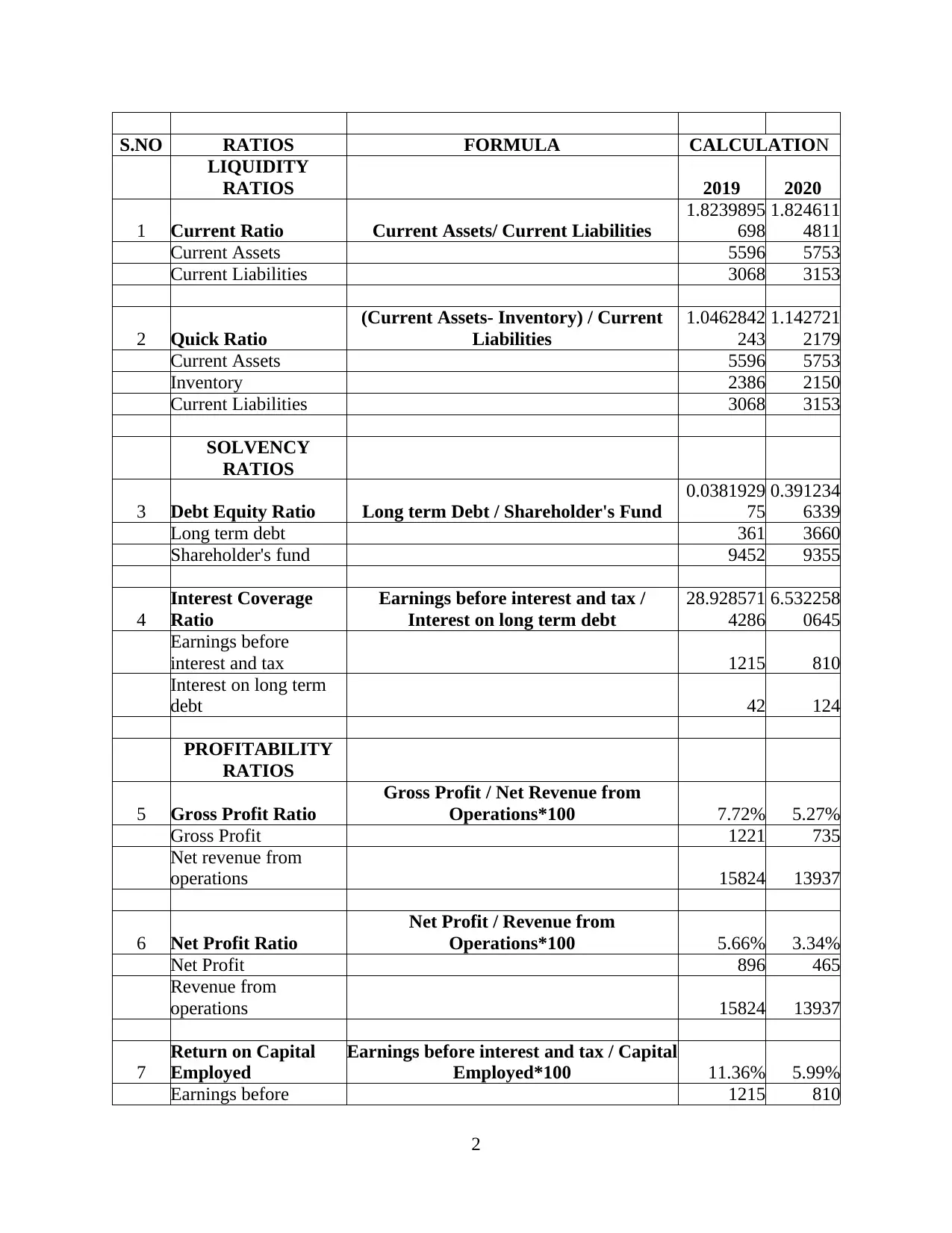
S.NO RATIOS FORMULA CALCULATION
LIQUIDITY
RATIOS 2019 2020
1 Current Ratio Current Assets/ Current Liabilities
1.8239895
698
1.824611
4811
Current Assets 5596 5753
Current Liabilities 3068 3153
2 Quick Ratio
(Current Assets- Inventory) / Current
Liabilities
1.0462842
243
1.142721
2179
Current Assets 5596 5753
Inventory 2386 2150
Current Liabilities 3068 3153
SOLVENCY
RATIOS
3 Debt Equity Ratio Long term Debt / Shareholder's Fund
0.0381929
75
0.391234
6339
Long term debt 361 3660
Shareholder's fund 9452 9355
4
Interest Coverage
Ratio
Earnings before interest and tax /
Interest on long term debt
28.928571
4286
6.532258
0645
Earnings before
interest and tax 1215 810
Interest on long term
debt 42 124
PROFITABILITY
RATIOS
5 Gross Profit Ratio
Gross Profit / Net Revenue from
Operations*100 7.72% 5.27%
Gross Profit 1221 735
Net revenue from
operations 15824 13937
6 Net Profit Ratio
Net Profit / Revenue from
Operations*100 5.66% 3.34%
Net Profit 896 465
Revenue from
operations 15824 13937
7
Return on Capital
Employed
Earnings before interest and tax / Capital
Employed*100 11.36% 5.99%
Earnings before 1215 810
2
LIQUIDITY
RATIOS 2019 2020
1 Current Ratio Current Assets/ Current Liabilities
1.8239895
698
1.824611
4811
Current Assets 5596 5753
Current Liabilities 3068 3153
2 Quick Ratio
(Current Assets- Inventory) / Current
Liabilities
1.0462842
243
1.142721
2179
Current Assets 5596 5753
Inventory 2386 2150
Current Liabilities 3068 3153
SOLVENCY
RATIOS
3 Debt Equity Ratio Long term Debt / Shareholder's Fund
0.0381929
75
0.391234
6339
Long term debt 361 3660
Shareholder's fund 9452 9355
4
Interest Coverage
Ratio
Earnings before interest and tax /
Interest on long term debt
28.928571
4286
6.532258
0645
Earnings before
interest and tax 1215 810
Interest on long term
debt 42 124
PROFITABILITY
RATIOS
5 Gross Profit Ratio
Gross Profit / Net Revenue from
Operations*100 7.72% 5.27%
Gross Profit 1221 735
Net revenue from
operations 15824 13937
6 Net Profit Ratio
Net Profit / Revenue from
Operations*100 5.66% 3.34%
Net Profit 896 465
Revenue from
operations 15824 13937
7
Return on Capital
Employed
Earnings before interest and tax / Capital
Employed*100 11.36% 5.99%
Earnings before 1215 810
2
Paraphrase This Document
Need a fresh take? Get an instant paraphrase of this document with our AI Paraphraser
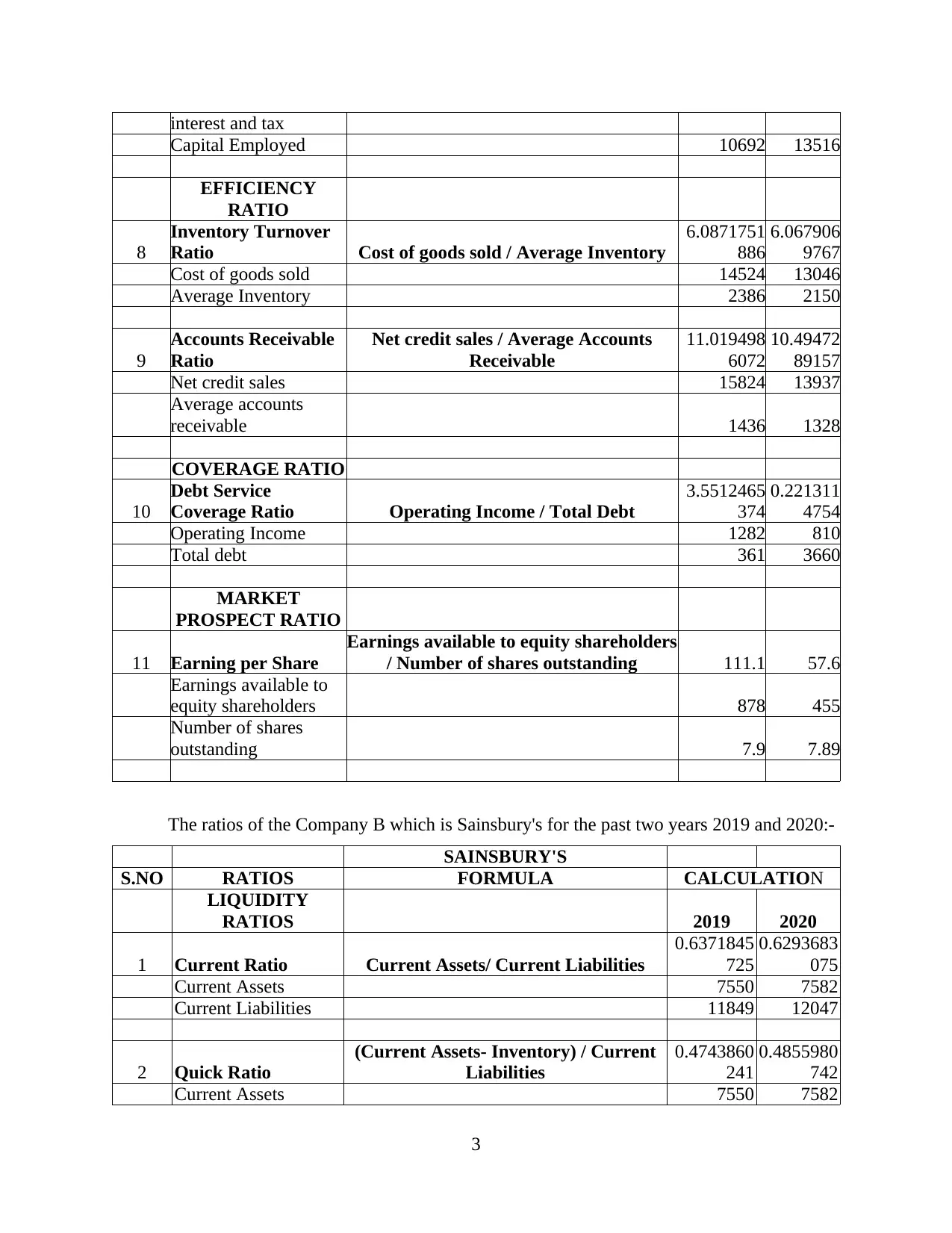
interest and tax
Capital Employed 10692 13516
EFFICIENCY
RATIO
8
Inventory Turnover
Ratio Cost of goods sold / Average Inventory
6.0871751
886
6.067906
9767
Cost of goods sold 14524 13046
Average Inventory 2386 2150
9
Accounts Receivable
Ratio
Net credit sales / Average Accounts
Receivable
11.019498
6072
10.49472
89157
Net credit sales 15824 13937
Average accounts
receivable 1436 1328
COVERAGE RATIO
10
Debt Service
Coverage Ratio Operating Income / Total Debt
3.5512465
374
0.221311
4754
Operating Income 1282 810
Total debt 361 3660
MARKET
PROSPECT RATIO
11 Earning per Share
Earnings available to equity shareholders
/ Number of shares outstanding 111.1 57.6
Earnings available to
equity shareholders 878 455
Number of shares
outstanding 7.9 7.89
The ratios of the Company B which is Sainsbury's for the past two years 2019 and 2020:-
SAINSBURY'S
S.NO RATIOS FORMULA CALCULATION
LIQUIDITY
RATIOS 2019 2020
1 Current Ratio Current Assets/ Current Liabilities
0.6371845
725
0.6293683
075
Current Assets 7550 7582
Current Liabilities 11849 12047
2 Quick Ratio
(Current Assets- Inventory) / Current
Liabilities
0.4743860
241
0.4855980
742
Current Assets 7550 7582
3
Capital Employed 10692 13516
EFFICIENCY
RATIO
8
Inventory Turnover
Ratio Cost of goods sold / Average Inventory
6.0871751
886
6.067906
9767
Cost of goods sold 14524 13046
Average Inventory 2386 2150
9
Accounts Receivable
Ratio
Net credit sales / Average Accounts
Receivable
11.019498
6072
10.49472
89157
Net credit sales 15824 13937
Average accounts
receivable 1436 1328
COVERAGE RATIO
10
Debt Service
Coverage Ratio Operating Income / Total Debt
3.5512465
374
0.221311
4754
Operating Income 1282 810
Total debt 361 3660
MARKET
PROSPECT RATIO
11 Earning per Share
Earnings available to equity shareholders
/ Number of shares outstanding 111.1 57.6
Earnings available to
equity shareholders 878 455
Number of shares
outstanding 7.9 7.89
The ratios of the Company B which is Sainsbury's for the past two years 2019 and 2020:-
SAINSBURY'S
S.NO RATIOS FORMULA CALCULATION
LIQUIDITY
RATIOS 2019 2020
1 Current Ratio Current Assets/ Current Liabilities
0.6371845
725
0.6293683
075
Current Assets 7550 7582
Current Liabilities 11849 12047
2 Quick Ratio
(Current Assets- Inventory) / Current
Liabilities
0.4743860
241
0.4855980
742
Current Assets 7550 7582
3
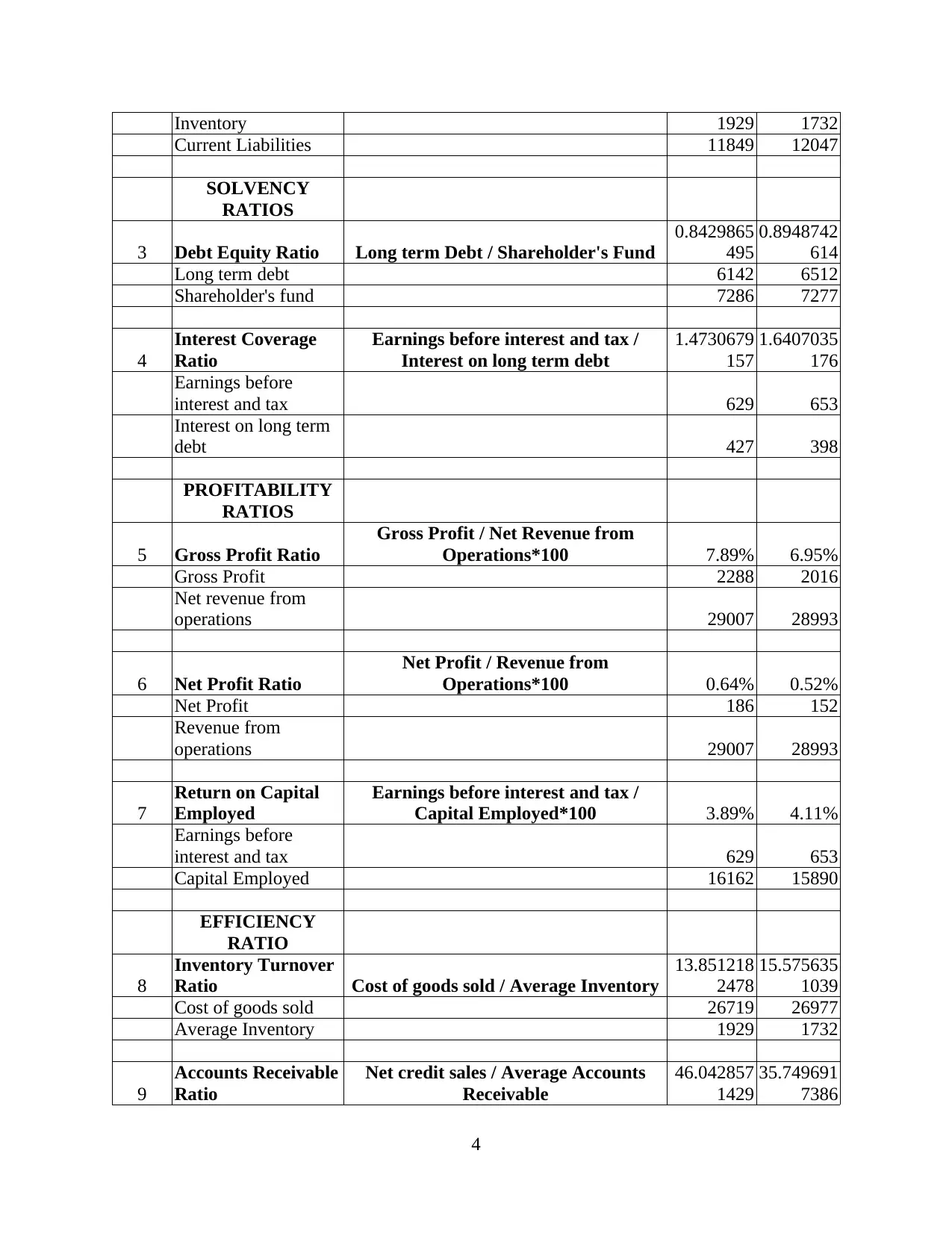
Inventory 1929 1732
Current Liabilities 11849 12047
SOLVENCY
RATIOS
3 Debt Equity Ratio Long term Debt / Shareholder's Fund
0.8429865
495
0.8948742
614
Long term debt 6142 6512
Shareholder's fund 7286 7277
4
Interest Coverage
Ratio
Earnings before interest and tax /
Interest on long term debt
1.4730679
157
1.6407035
176
Earnings before
interest and tax 629 653
Interest on long term
debt 427 398
PROFITABILITY
RATIOS
5 Gross Profit Ratio
Gross Profit / Net Revenue from
Operations*100 7.89% 6.95%
Gross Profit 2288 2016
Net revenue from
operations 29007 28993
6 Net Profit Ratio
Net Profit / Revenue from
Operations*100 0.64% 0.52%
Net Profit 186 152
Revenue from
operations 29007 28993
7
Return on Capital
Employed
Earnings before interest and tax /
Capital Employed*100 3.89% 4.11%
Earnings before
interest and tax 629 653
Capital Employed 16162 15890
EFFICIENCY
RATIO
8
Inventory Turnover
Ratio Cost of goods sold / Average Inventory
13.851218
2478
15.575635
1039
Cost of goods sold 26719 26977
Average Inventory 1929 1732
9
Accounts Receivable
Ratio
Net credit sales / Average Accounts
Receivable
46.042857
1429
35.749691
7386
4
Current Liabilities 11849 12047
SOLVENCY
RATIOS
3 Debt Equity Ratio Long term Debt / Shareholder's Fund
0.8429865
495
0.8948742
614
Long term debt 6142 6512
Shareholder's fund 7286 7277
4
Interest Coverage
Ratio
Earnings before interest and tax /
Interest on long term debt
1.4730679
157
1.6407035
176
Earnings before
interest and tax 629 653
Interest on long term
debt 427 398
PROFITABILITY
RATIOS
5 Gross Profit Ratio
Gross Profit / Net Revenue from
Operations*100 7.89% 6.95%
Gross Profit 2288 2016
Net revenue from
operations 29007 28993
6 Net Profit Ratio
Net Profit / Revenue from
Operations*100 0.64% 0.52%
Net Profit 186 152
Revenue from
operations 29007 28993
7
Return on Capital
Employed
Earnings before interest and tax /
Capital Employed*100 3.89% 4.11%
Earnings before
interest and tax 629 653
Capital Employed 16162 15890
EFFICIENCY
RATIO
8
Inventory Turnover
Ratio Cost of goods sold / Average Inventory
13.851218
2478
15.575635
1039
Cost of goods sold 26719 26977
Average Inventory 1929 1732
9
Accounts Receivable
Ratio
Net credit sales / Average Accounts
Receivable
46.042857
1429
35.749691
7386
4
⊘ This is a preview!⊘
Do you want full access?
Subscribe today to unlock all pages.

Trusted by 1+ million students worldwide
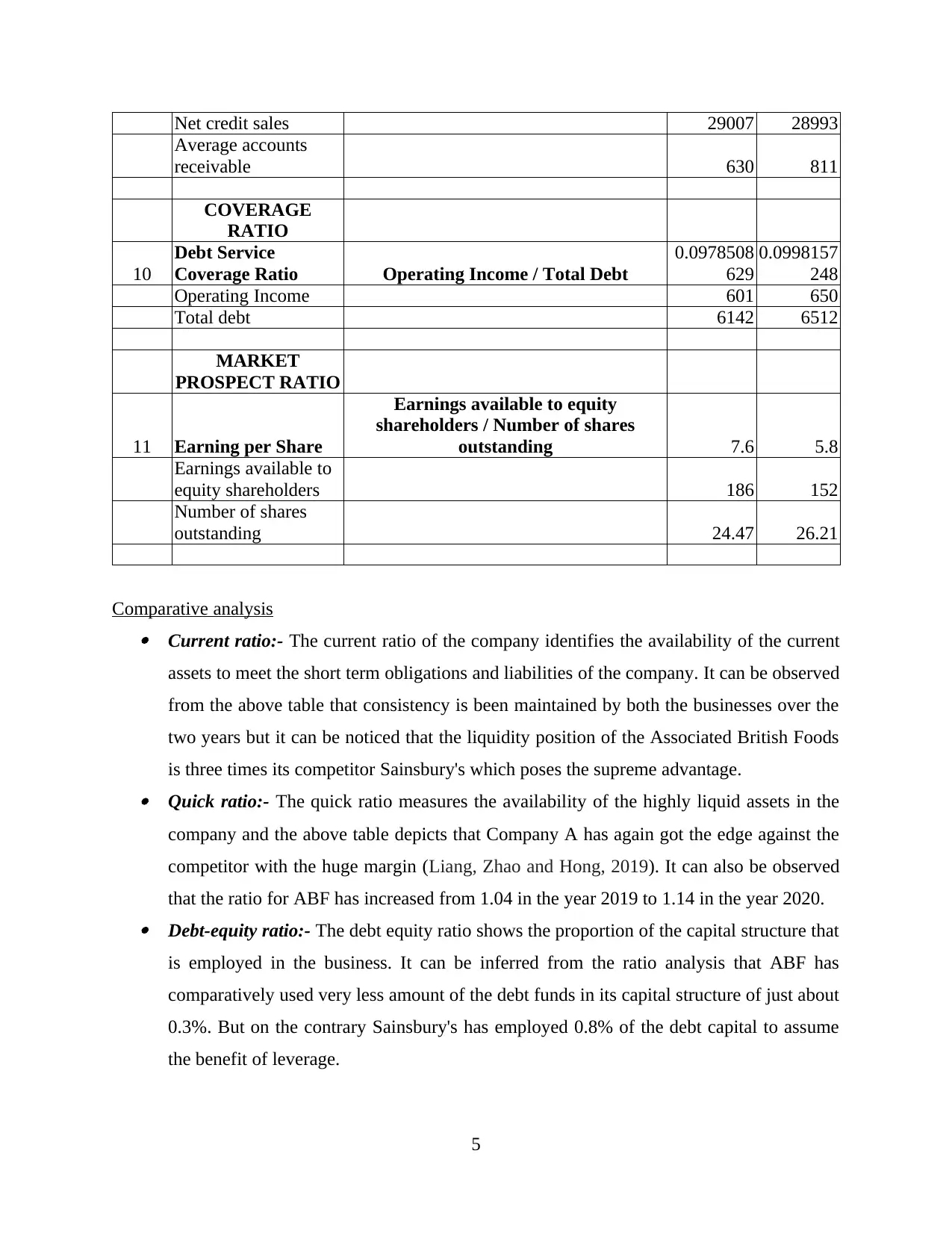
Net credit sales 29007 28993
Average accounts
receivable 630 811
COVERAGE
RATIO
10
Debt Service
Coverage Ratio Operating Income / Total Debt
0.0978508
629
0.0998157
248
Operating Income 601 650
Total debt 6142 6512
MARKET
PROSPECT RATIO
11 Earning per Share
Earnings available to equity
shareholders / Number of shares
outstanding 7.6 5.8
Earnings available to
equity shareholders 186 152
Number of shares
outstanding 24.47 26.21
Comparative analysis Current ratio:- The current ratio of the company identifies the availability of the current
assets to meet the short term obligations and liabilities of the company. It can be observed
from the above table that consistency is been maintained by both the businesses over the
two years but it can be noticed that the liquidity position of the Associated British Foods
is three times its competitor Sainsbury's which poses the supreme advantage. Quick ratio:- The quick ratio measures the availability of the highly liquid assets in the
company and the above table depicts that Company A has again got the edge against the
competitor with the huge margin (Liang, Zhao and Hong, 2019). It can also be observed
that the ratio for ABF has increased from 1.04 in the year 2019 to 1.14 in the year 2020. Debt-equity ratio:- The debt equity ratio shows the proportion of the capital structure that
is employed in the business. It can be inferred from the ratio analysis that ABF has
comparatively used very less amount of the debt funds in its capital structure of just about
0.3%. But on the contrary Sainsbury's has employed 0.8% of the debt capital to assume
the benefit of leverage.
5
Average accounts
receivable 630 811
COVERAGE
RATIO
10
Debt Service
Coverage Ratio Operating Income / Total Debt
0.0978508
629
0.0998157
248
Operating Income 601 650
Total debt 6142 6512
MARKET
PROSPECT RATIO
11 Earning per Share
Earnings available to equity
shareholders / Number of shares
outstanding 7.6 5.8
Earnings available to
equity shareholders 186 152
Number of shares
outstanding 24.47 26.21
Comparative analysis Current ratio:- The current ratio of the company identifies the availability of the current
assets to meet the short term obligations and liabilities of the company. It can be observed
from the above table that consistency is been maintained by both the businesses over the
two years but it can be noticed that the liquidity position of the Associated British Foods
is three times its competitor Sainsbury's which poses the supreme advantage. Quick ratio:- The quick ratio measures the availability of the highly liquid assets in the
company and the above table depicts that Company A has again got the edge against the
competitor with the huge margin (Liang, Zhao and Hong, 2019). It can also be observed
that the ratio for ABF has increased from 1.04 in the year 2019 to 1.14 in the year 2020. Debt-equity ratio:- The debt equity ratio shows the proportion of the capital structure that
is employed in the business. It can be inferred from the ratio analysis that ABF has
comparatively used very less amount of the debt funds in its capital structure of just about
0.3%. But on the contrary Sainsbury's has employed 0.8% of the debt capital to assume
the benefit of leverage.
5
Paraphrase This Document
Need a fresh take? Get an instant paraphrase of this document with our AI Paraphraser
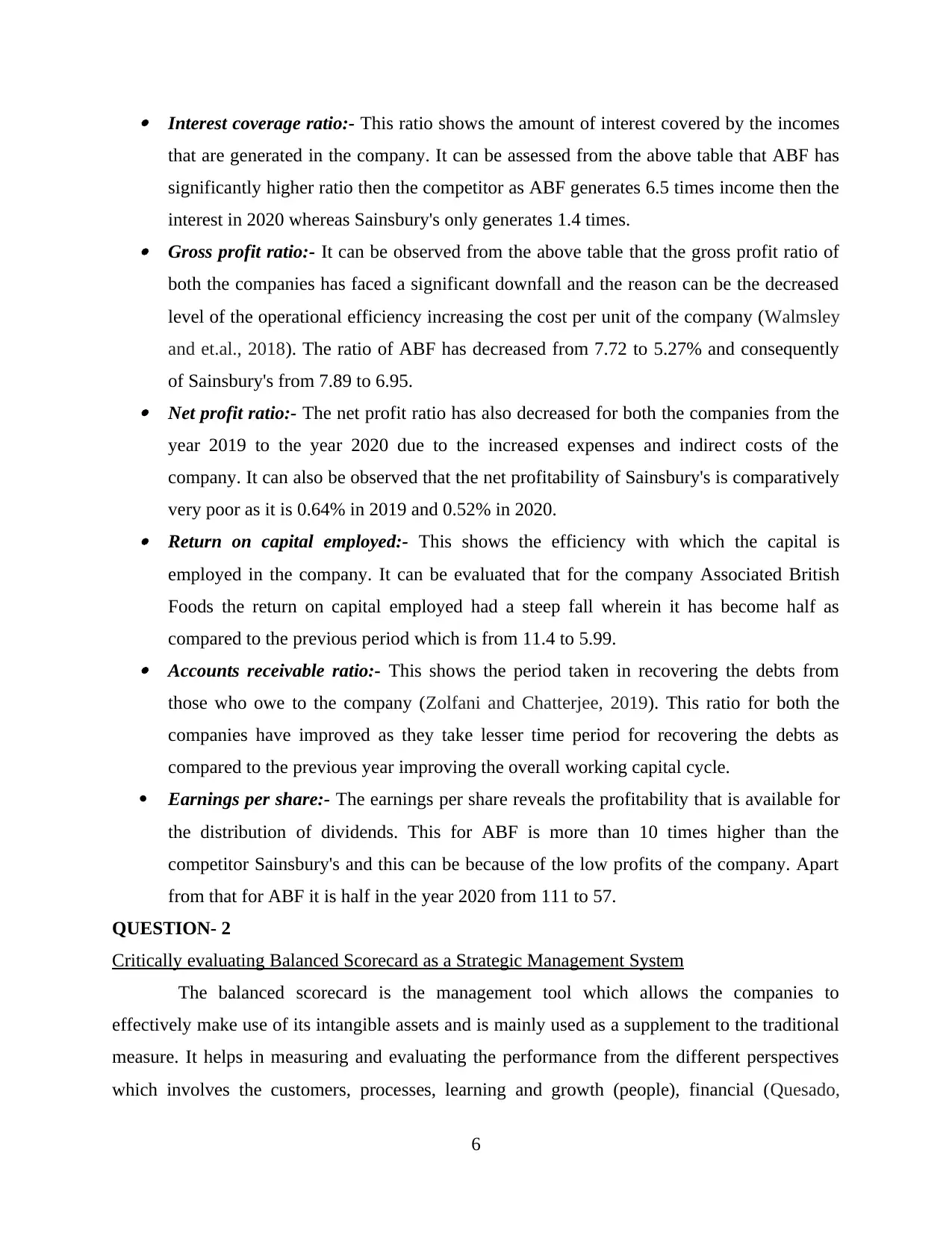
Interest coverage ratio:- This ratio shows the amount of interest covered by the incomes
that are generated in the company. It can be assessed from the above table that ABF has
significantly higher ratio then the competitor as ABF generates 6.5 times income then the
interest in 2020 whereas Sainsbury's only generates 1.4 times. Gross profit ratio:- It can be observed from the above table that the gross profit ratio of
both the companies has faced a significant downfall and the reason can be the decreased
level of the operational efficiency increasing the cost per unit of the company (Walmsley
and et.al., 2018). The ratio of ABF has decreased from 7.72 to 5.27% and consequently
of Sainsbury's from 7.89 to 6.95. Net profit ratio:- The net profit ratio has also decreased for both the companies from the
year 2019 to the year 2020 due to the increased expenses and indirect costs of the
company. It can also be observed that the net profitability of Sainsbury's is comparatively
very poor as it is 0.64% in 2019 and 0.52% in 2020. Return on capital employed:- This shows the efficiency with which the capital is
employed in the company. It can be evaluated that for the company Associated British
Foods the return on capital employed had a steep fall wherein it has become half as
compared to the previous period which is from 11.4 to 5.99. Accounts receivable ratio:- This shows the period taken in recovering the debts from
those who owe to the company (Zolfani and Chatterjee, 2019). This ratio for both the
companies have improved as they take lesser time period for recovering the debts as
compared to the previous year improving the overall working capital cycle.
Earnings per share:- The earnings per share reveals the profitability that is available for
the distribution of dividends. This for ABF is more than 10 times higher than the
competitor Sainsbury's and this can be because of the low profits of the company. Apart
from that for ABF it is half in the year 2020 from 111 to 57.
QUESTION- 2
Critically evaluating Balanced Scorecard as a Strategic Management System
The balanced scorecard is the management tool which allows the companies to
effectively make use of its intangible assets and is mainly used as a supplement to the traditional
measure. It helps in measuring and evaluating the performance from the different perspectives
which involves the customers, processes, learning and growth (people), financial (Quesado,
6
that are generated in the company. It can be assessed from the above table that ABF has
significantly higher ratio then the competitor as ABF generates 6.5 times income then the
interest in 2020 whereas Sainsbury's only generates 1.4 times. Gross profit ratio:- It can be observed from the above table that the gross profit ratio of
both the companies has faced a significant downfall and the reason can be the decreased
level of the operational efficiency increasing the cost per unit of the company (Walmsley
and et.al., 2018). The ratio of ABF has decreased from 7.72 to 5.27% and consequently
of Sainsbury's from 7.89 to 6.95. Net profit ratio:- The net profit ratio has also decreased for both the companies from the
year 2019 to the year 2020 due to the increased expenses and indirect costs of the
company. It can also be observed that the net profitability of Sainsbury's is comparatively
very poor as it is 0.64% in 2019 and 0.52% in 2020. Return on capital employed:- This shows the efficiency with which the capital is
employed in the company. It can be evaluated that for the company Associated British
Foods the return on capital employed had a steep fall wherein it has become half as
compared to the previous period which is from 11.4 to 5.99. Accounts receivable ratio:- This shows the period taken in recovering the debts from
those who owe to the company (Zolfani and Chatterjee, 2019). This ratio for both the
companies have improved as they take lesser time period for recovering the debts as
compared to the previous year improving the overall working capital cycle.
Earnings per share:- The earnings per share reveals the profitability that is available for
the distribution of dividends. This for ABF is more than 10 times higher than the
competitor Sainsbury's and this can be because of the low profits of the company. Apart
from that for ABF it is half in the year 2020 from 111 to 57.
QUESTION- 2
Critically evaluating Balanced Scorecard as a Strategic Management System
The balanced scorecard is the management tool which allows the companies to
effectively make use of its intangible assets and is mainly used as a supplement to the traditional
measure. It helps in measuring and evaluating the performance from the different perspectives
which involves the customers, processes, learning and growth (people), financial (Quesado,
6
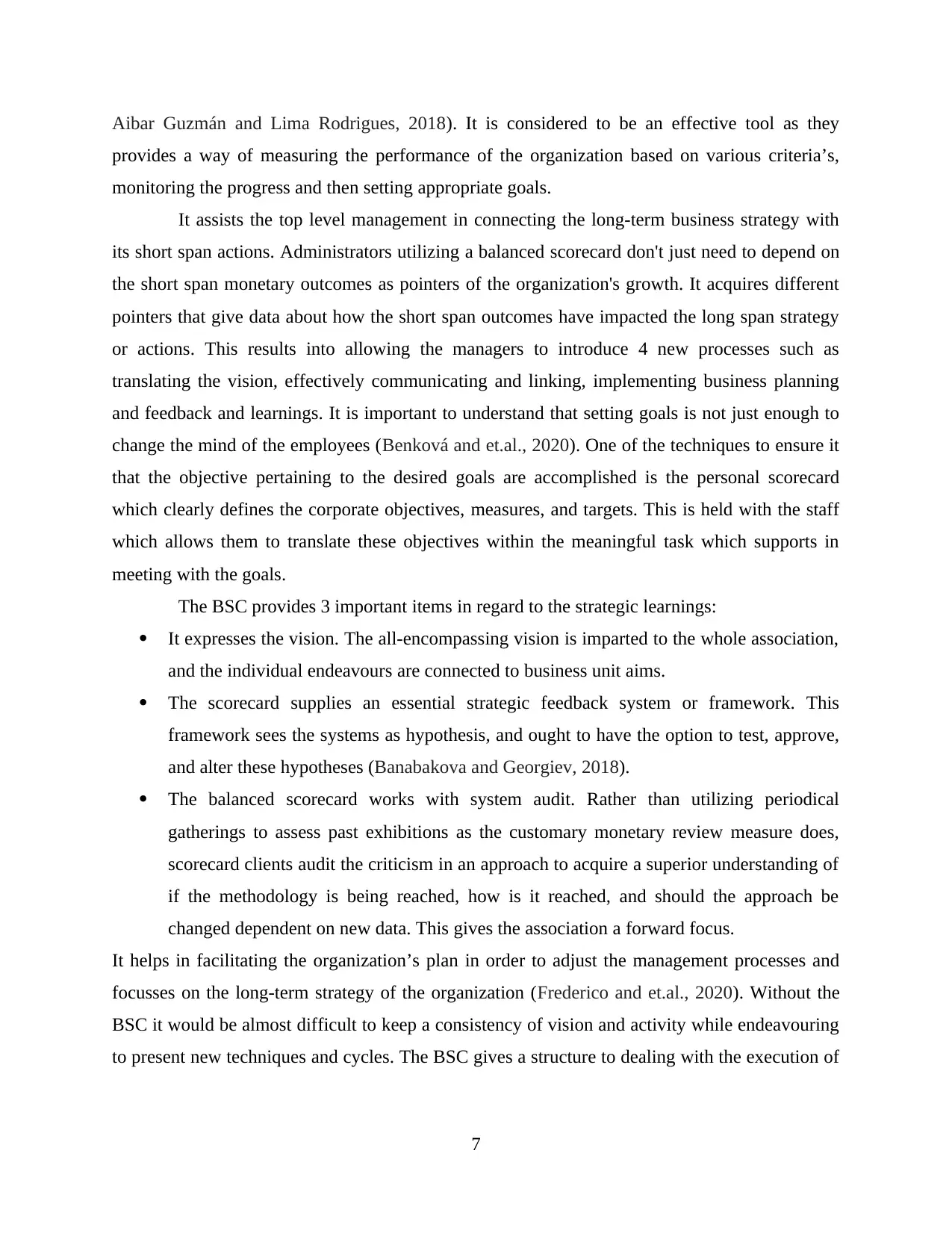
Aibar Guzmán and Lima Rodrigues, 2018). It is considered to be an effective tool as they
provides a way of measuring the performance of the organization based on various criteria’s,
monitoring the progress and then setting appropriate goals.
It assists the top level management in connecting the long-term business strategy with
its short span actions. Administrators utilizing a balanced scorecard don't just need to depend on
the short span monetary outcomes as pointers of the organization's growth. It acquires different
pointers that give data about how the short span outcomes have impacted the long span strategy
or actions. This results into allowing the managers to introduce 4 new processes such as
translating the vision, effectively communicating and linking, implementing business planning
and feedback and learnings. It is important to understand that setting goals is not just enough to
change the mind of the employees (Benková and et.al., 2020). One of the techniques to ensure it
that the objective pertaining to the desired goals are accomplished is the personal scorecard
which clearly defines the corporate objectives, measures, and targets. This is held with the staff
which allows them to translate these objectives within the meaningful task which supports in
meeting with the goals.
The BSC provides 3 important items in regard to the strategic learnings:
It expresses the vision. The all-encompassing vision is imparted to the whole association,
and the individual endeavours are connected to business unit aims.
The scorecard supplies an essential strategic feedback system or framework. This
framework sees the systems as hypothesis, and ought to have the option to test, approve,
and alter these hypotheses (Banabakova and Georgiev, 2018).
The balanced scorecard works with system audit. Rather than utilizing periodical
gatherings to assess past exhibitions as the customary monetary review measure does,
scorecard clients audit the criticism in an approach to acquire a superior understanding of
if the methodology is being reached, how is it reached, and should the approach be
changed dependent on new data. This gives the association a forward focus.
It helps in facilitating the organization’s plan in order to adjust the management processes and
focusses on the long-term strategy of the organization (Frederico and et.al., 2020). Without the
BSC it would be almost difficult to keep a consistency of vision and activity while endeavouring
to present new techniques and cycles. The BSC gives a structure to dealing with the execution of
7
provides a way of measuring the performance of the organization based on various criteria’s,
monitoring the progress and then setting appropriate goals.
It assists the top level management in connecting the long-term business strategy with
its short span actions. Administrators utilizing a balanced scorecard don't just need to depend on
the short span monetary outcomes as pointers of the organization's growth. It acquires different
pointers that give data about how the short span outcomes have impacted the long span strategy
or actions. This results into allowing the managers to introduce 4 new processes such as
translating the vision, effectively communicating and linking, implementing business planning
and feedback and learnings. It is important to understand that setting goals is not just enough to
change the mind of the employees (Benková and et.al., 2020). One of the techniques to ensure it
that the objective pertaining to the desired goals are accomplished is the personal scorecard
which clearly defines the corporate objectives, measures, and targets. This is held with the staff
which allows them to translate these objectives within the meaningful task which supports in
meeting with the goals.
The BSC provides 3 important items in regard to the strategic learnings:
It expresses the vision. The all-encompassing vision is imparted to the whole association,
and the individual endeavours are connected to business unit aims.
The scorecard supplies an essential strategic feedback system or framework. This
framework sees the systems as hypothesis, and ought to have the option to test, approve,
and alter these hypotheses (Banabakova and Georgiev, 2018).
The balanced scorecard works with system audit. Rather than utilizing periodical
gatherings to assess past exhibitions as the customary monetary review measure does,
scorecard clients audit the criticism in an approach to acquire a superior understanding of
if the methodology is being reached, how is it reached, and should the approach be
changed dependent on new data. This gives the association a forward focus.
It helps in facilitating the organization’s plan in order to adjust the management processes and
focusses on the long-term strategy of the organization (Frederico and et.al., 2020). Without the
BSC it would be almost difficult to keep a consistency of vision and activity while endeavouring
to present new techniques and cycles. The BSC gives a structure to dealing with the execution of
7
⊘ This is a preview!⊘
Do you want full access?
Subscribe today to unlock all pages.

Trusted by 1+ million students worldwide
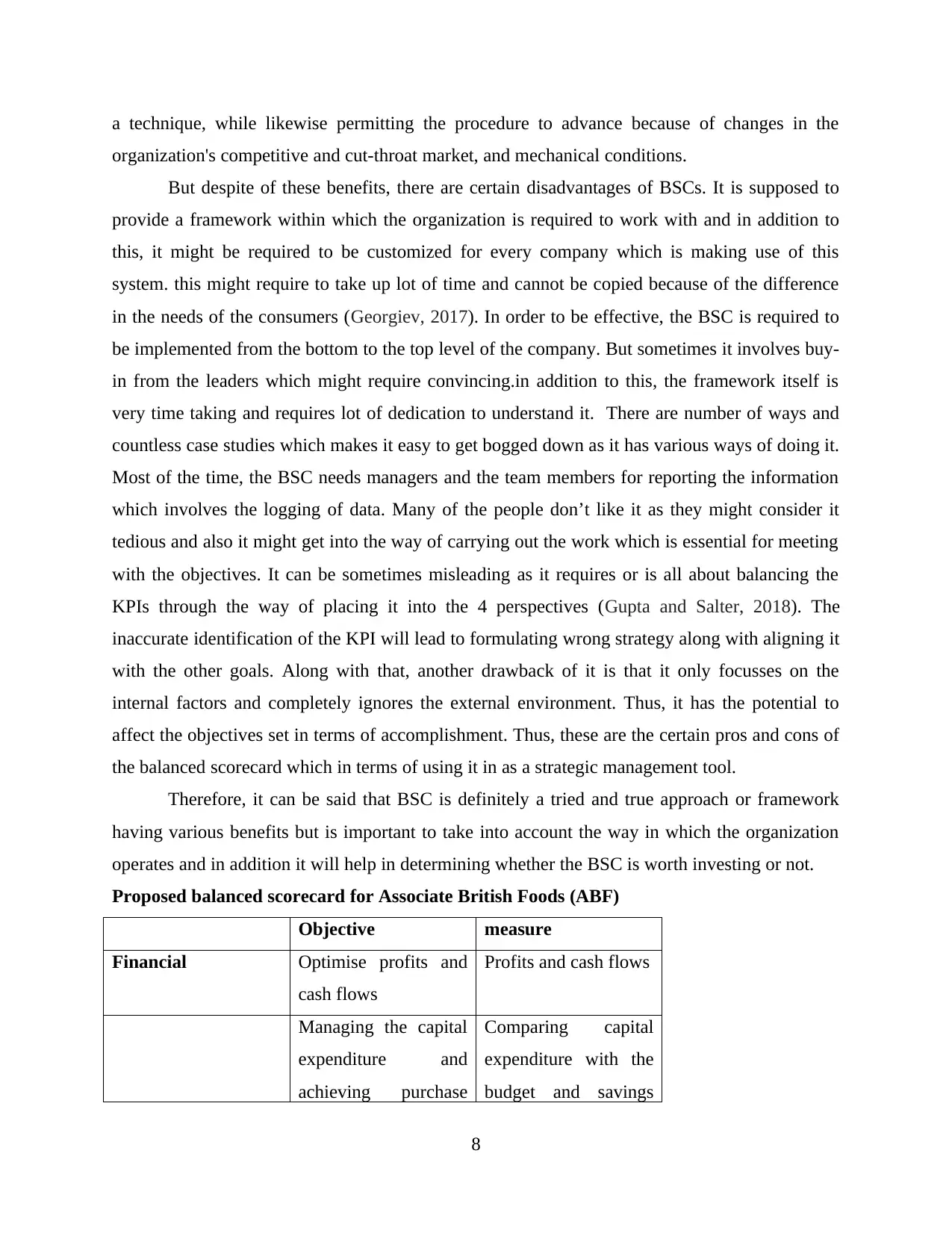
a technique, while likewise permitting the procedure to advance because of changes in the
organization's competitive and cut-throat market, and mechanical conditions.
But despite of these benefits, there are certain disadvantages of BSCs. It is supposed to
provide a framework within which the organization is required to work with and in addition to
this, it might be required to be customized for every company which is making use of this
system. this might require to take up lot of time and cannot be copied because of the difference
in the needs of the consumers (Georgiev, 2017). In order to be effective, the BSC is required to
be implemented from the bottom to the top level of the company. But sometimes it involves buy-
in from the leaders which might require convincing.in addition to this, the framework itself is
very time taking and requires lot of dedication to understand it. There are number of ways and
countless case studies which makes it easy to get bogged down as it has various ways of doing it.
Most of the time, the BSC needs managers and the team members for reporting the information
which involves the logging of data. Many of the people don’t like it as they might consider it
tedious and also it might get into the way of carrying out the work which is essential for meeting
with the objectives. It can be sometimes misleading as it requires or is all about balancing the
KPIs through the way of placing it into the 4 perspectives (Gupta and Salter, 2018). The
inaccurate identification of the KPI will lead to formulating wrong strategy along with aligning it
with the other goals. Along with that, another drawback of it is that it only focusses on the
internal factors and completely ignores the external environment. Thus, it has the potential to
affect the objectives set in terms of accomplishment. Thus, these are the certain pros and cons of
the balanced scorecard which in terms of using it in as a strategic management tool.
Therefore, it can be said that BSC is definitely a tried and true approach or framework
having various benefits but is important to take into account the way in which the organization
operates and in addition it will help in determining whether the BSC is worth investing or not.
Proposed balanced scorecard for Associate British Foods (ABF)
Objective measure
Financial Optimise profits and
cash flows
Profits and cash flows
Managing the capital
expenditure and
achieving purchase
Comparing capital
expenditure with the
budget and savings
8
organization's competitive and cut-throat market, and mechanical conditions.
But despite of these benefits, there are certain disadvantages of BSCs. It is supposed to
provide a framework within which the organization is required to work with and in addition to
this, it might be required to be customized for every company which is making use of this
system. this might require to take up lot of time and cannot be copied because of the difference
in the needs of the consumers (Georgiev, 2017). In order to be effective, the BSC is required to
be implemented from the bottom to the top level of the company. But sometimes it involves buy-
in from the leaders which might require convincing.in addition to this, the framework itself is
very time taking and requires lot of dedication to understand it. There are number of ways and
countless case studies which makes it easy to get bogged down as it has various ways of doing it.
Most of the time, the BSC needs managers and the team members for reporting the information
which involves the logging of data. Many of the people don’t like it as they might consider it
tedious and also it might get into the way of carrying out the work which is essential for meeting
with the objectives. It can be sometimes misleading as it requires or is all about balancing the
KPIs through the way of placing it into the 4 perspectives (Gupta and Salter, 2018). The
inaccurate identification of the KPI will lead to formulating wrong strategy along with aligning it
with the other goals. Along with that, another drawback of it is that it only focusses on the
internal factors and completely ignores the external environment. Thus, it has the potential to
affect the objectives set in terms of accomplishment. Thus, these are the certain pros and cons of
the balanced scorecard which in terms of using it in as a strategic management tool.
Therefore, it can be said that BSC is definitely a tried and true approach or framework
having various benefits but is important to take into account the way in which the organization
operates and in addition it will help in determining whether the BSC is worth investing or not.
Proposed balanced scorecard for Associate British Foods (ABF)
Objective measure
Financial Optimise profits and
cash flows
Profits and cash flows
Managing the capital
expenditure and
achieving purchase
Comparing capital
expenditure with the
budget and savings
8
Paraphrase This Document
Need a fresh take? Get an instant paraphrase of this document with our AI Paraphraser
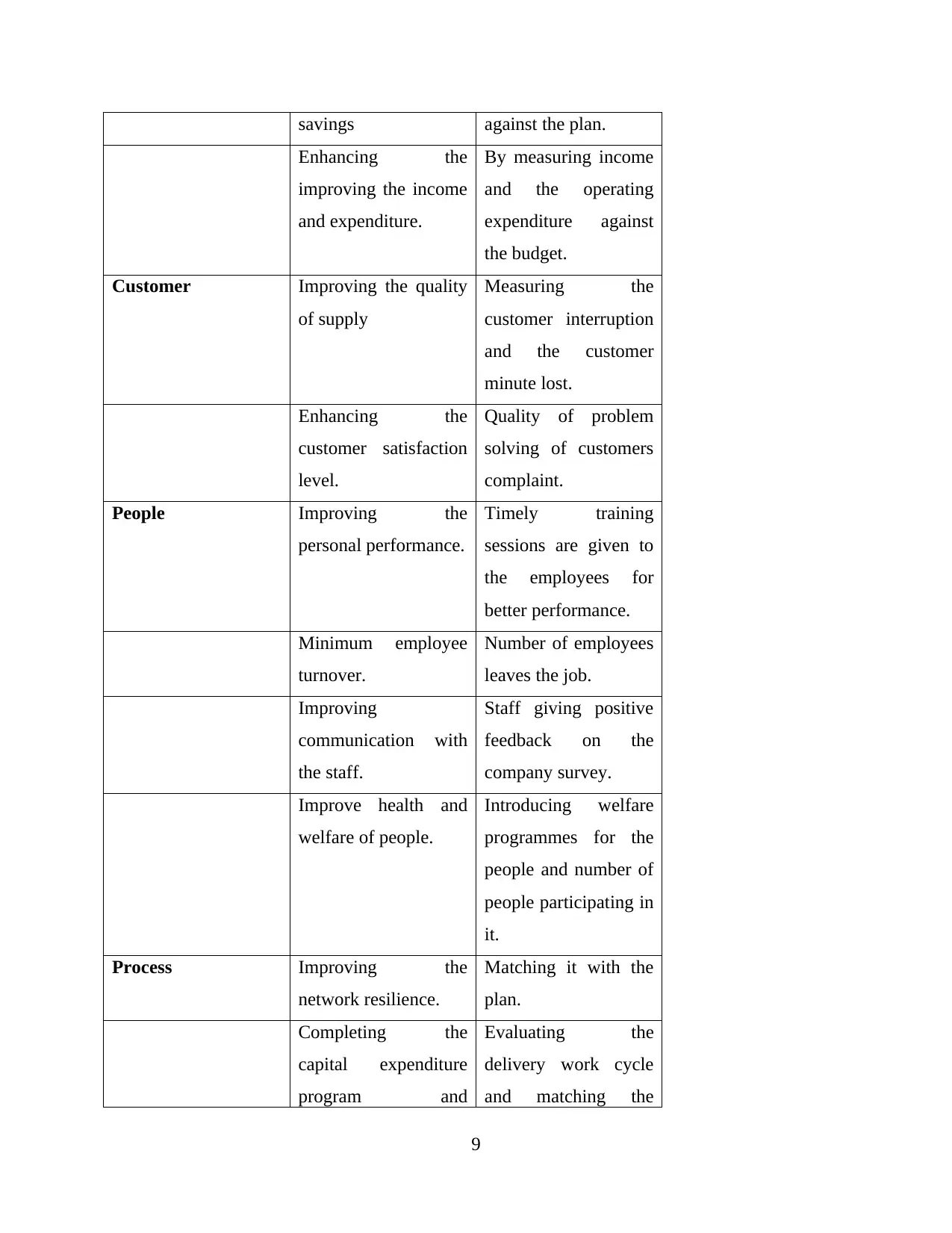
savings against the plan.
Enhancing the
improving the income
and expenditure.
By measuring income
and the operating
expenditure against
the budget.
Customer Improving the quality
of supply
Measuring the
customer interruption
and the customer
minute lost.
Enhancing the
customer satisfaction
level.
Quality of problem
solving of customers
complaint.
People Improving the
personal performance.
Timely training
sessions are given to
the employees for
better performance.
Minimum employee
turnover.
Number of employees
leaves the job.
Improving
communication with
the staff.
Staff giving positive
feedback on the
company survey.
Improve health and
welfare of people.
Introducing welfare
programmes for the
people and number of
people participating in
it.
Process Improving the
network resilience.
Matching it with the
plan.
Completing the
capital expenditure
program and
Evaluating the
delivery work cycle
and matching the
9
Enhancing the
improving the income
and expenditure.
By measuring income
and the operating
expenditure against
the budget.
Customer Improving the quality
of supply
Measuring the
customer interruption
and the customer
minute lost.
Enhancing the
customer satisfaction
level.
Quality of problem
solving of customers
complaint.
People Improving the
personal performance.
Timely training
sessions are given to
the employees for
better performance.
Minimum employee
turnover.
Number of employees
leaves the job.
Improving
communication with
the staff.
Staff giving positive
feedback on the
company survey.
Improve health and
welfare of people.
Introducing welfare
programmes for the
people and number of
people participating in
it.
Process Improving the
network resilience.
Matching it with the
plan.
Completing the
capital expenditure
program and
Evaluating the
delivery work cycle
and matching the
9
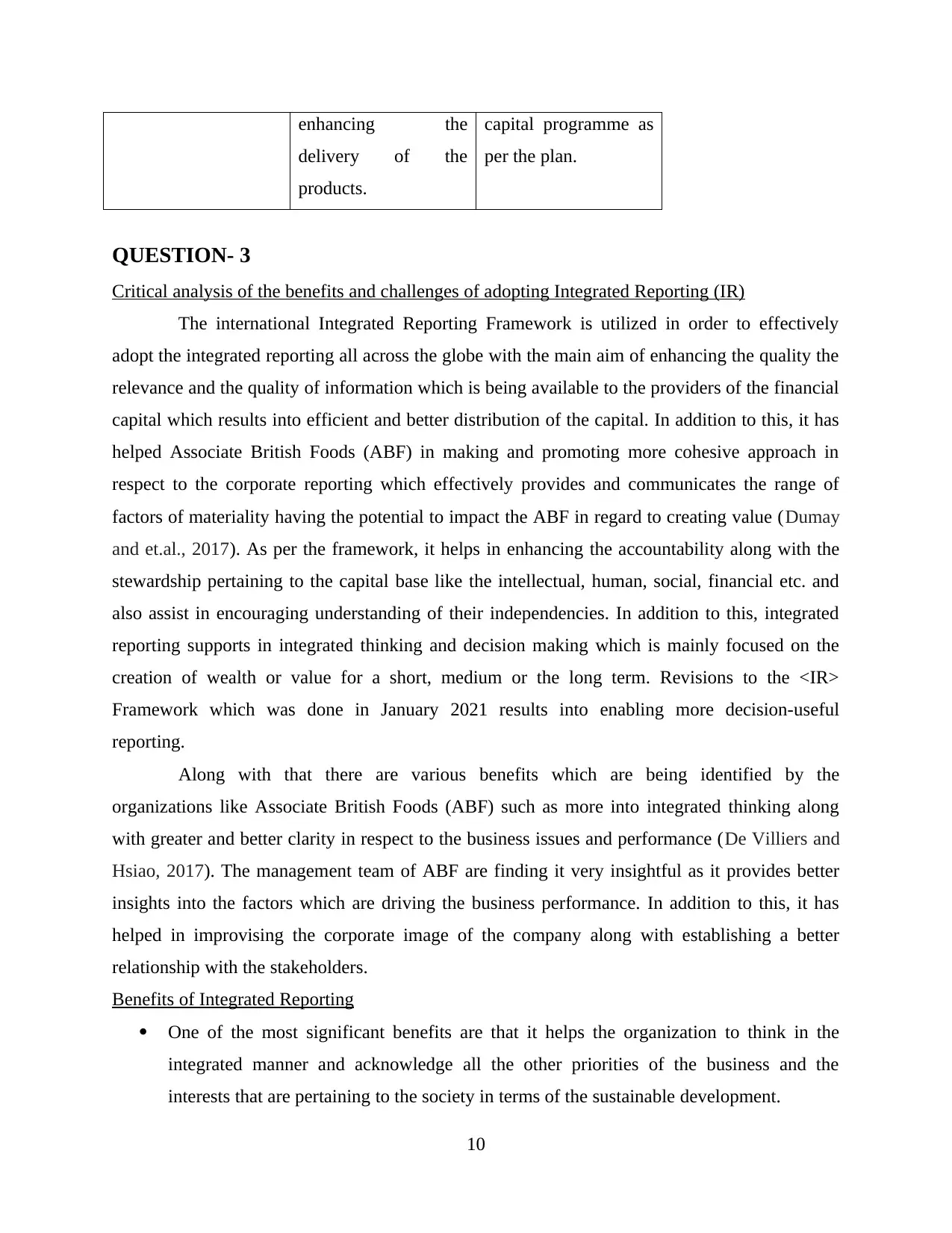
enhancing the
delivery of the
products.
capital programme as
per the plan.
QUESTION- 3
Critical analysis of the benefits and challenges of adopting Integrated Reporting (IR)
The international Integrated Reporting Framework is utilized in order to effectively
adopt the integrated reporting all across the globe with the main aim of enhancing the quality the
relevance and the quality of information which is being available to the providers of the financial
capital which results into efficient and better distribution of the capital. In addition to this, it has
helped Associate British Foods (ABF) in making and promoting more cohesive approach in
respect to the corporate reporting which effectively provides and communicates the range of
factors of materiality having the potential to impact the ABF in regard to creating value (Dumay
and et.al., 2017). As per the framework, it helps in enhancing the accountability along with the
stewardship pertaining to the capital base like the intellectual, human, social, financial etc. and
also assist in encouraging understanding of their independencies. In addition to this, integrated
reporting supports in integrated thinking and decision making which is mainly focused on the
creation of wealth or value for a short, medium or the long term. Revisions to the <IR>
Framework which was done in January 2021 results into enabling more decision-useful
reporting.
Along with that there are various benefits which are being identified by the
organizations like Associate British Foods (ABF) such as more into integrated thinking along
with greater and better clarity in respect to the business issues and performance (De Villiers and
Hsiao, 2017). The management team of ABF are finding it very insightful as it provides better
insights into the factors which are driving the business performance. In addition to this, it has
helped in improvising the corporate image of the company along with establishing a better
relationship with the stakeholders.
Benefits of Integrated Reporting
One of the most significant benefits are that it helps the organization to think in the
integrated manner and acknowledge all the other priorities of the business and the
interests that are pertaining to the society in terms of the sustainable development.
10
delivery of the
products.
capital programme as
per the plan.
QUESTION- 3
Critical analysis of the benefits and challenges of adopting Integrated Reporting (IR)
The international Integrated Reporting Framework is utilized in order to effectively
adopt the integrated reporting all across the globe with the main aim of enhancing the quality the
relevance and the quality of information which is being available to the providers of the financial
capital which results into efficient and better distribution of the capital. In addition to this, it has
helped Associate British Foods (ABF) in making and promoting more cohesive approach in
respect to the corporate reporting which effectively provides and communicates the range of
factors of materiality having the potential to impact the ABF in regard to creating value (Dumay
and et.al., 2017). As per the framework, it helps in enhancing the accountability along with the
stewardship pertaining to the capital base like the intellectual, human, social, financial etc. and
also assist in encouraging understanding of their independencies. In addition to this, integrated
reporting supports in integrated thinking and decision making which is mainly focused on the
creation of wealth or value for a short, medium or the long term. Revisions to the <IR>
Framework which was done in January 2021 results into enabling more decision-useful
reporting.
Along with that there are various benefits which are being identified by the
organizations like Associate British Foods (ABF) such as more into integrated thinking along
with greater and better clarity in respect to the business issues and performance (De Villiers and
Hsiao, 2017). The management team of ABF are finding it very insightful as it provides better
insights into the factors which are driving the business performance. In addition to this, it has
helped in improvising the corporate image of the company along with establishing a better
relationship with the stakeholders.
Benefits of Integrated Reporting
One of the most significant benefits are that it helps the organization to think in the
integrated manner and acknowledge all the other priorities of the business and the
interests that are pertaining to the society in terms of the sustainable development.
10
⊘ This is a preview!⊘
Do you want full access?
Subscribe today to unlock all pages.

Trusted by 1+ million students worldwide
1 out of 16
Related Documents
Your All-in-One AI-Powered Toolkit for Academic Success.
+13062052269
info@desklib.com
Available 24*7 on WhatsApp / Email
![[object Object]](/_next/static/media/star-bottom.7253800d.svg)
Unlock your academic potential
Copyright © 2020–2025 A2Z Services. All Rights Reserved. Developed and managed by ZUCOL.





